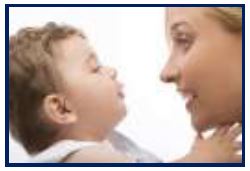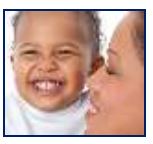Language Development Begins Early
From the moment babies are born, they are learning how to communicate. Babies first communicate by crying and then begin to coo and babble. Infants’ speech develops as they are exposed to sounds and language, spoken and unspoken. Gestures, facial expressions and sounds are all part of language development.


From the moment babies are born, they are learning how to communicate. Babies first communicate by crying and then begin to coo and babble. Infants’ speech develops as they are exposed to sounds and language, spoken and unspoken. Gestures, facial expressions and sounds are all part of language development.
Infant Language Development
Some common characteristics of language development include:
Newborns to 3-month-olds
- Turn toward familiar sounds and make eye contact.
- Recognize parents’ voices.
- Coo, make sounds.
- Use differing types of crying to express different needs.
- Smile when they see parents or familiar faces.
- Mimic facial expressions.

4- to 6-month-olds
- Watch speaker’s face when someone talks.
- Show excitement at familiar voices.
- Respond to different tones in voices.
- Begin babbling a variety of sounds.
- Respond to conversation by making sounds in reply.
7-month to 1-year-old
- Enjoy playing repetitive games like peek a boo.
- Turn head and follow sounds with eyes.
- Understand frequently heard words.
- Respond to simple requests.
- Babble using long and short groups of sounds (tata, upup, bibibi) and make babbling sounds as if they are making sense.
- Babble to communicate desire for attention or help.
- Use nonverbal communication (waving bye-bye).
- Imitate different speech sounds.
- Can speak one or more words.
Adapted from NIH.
Babbling Matters
Babies’ first words are usually a momentous step in language learning, but how about the babbling that proceeds talking? As a parent, you might think that babies are just making silly noises, but infants are actually attempting to communicate and tell their story. Several recent studies indicated that babies’ babbling plays a role in future language development. Additionally, how caregivers respond to their babies’ babbling can actually shape the way they communicate and use vocalizations.1 The more caregivers use parentese (a simple repetitive speech with exaggerated intonation and rhythm), the more babies are encouraged to babble. Babbling back at babies has been shown to accelerate infants’ vocalizing and language development.

How to Help Babies Learn Language
Parents or caregivers can help babies develop solid language skills through talking, singing, playing and reading.
Speak with your baby frequently
In general, the more parents or caregivers speak with babies, the greater the opportunities for babies to learn vocabulary and develop strong language and communication skills. In general, babies are exposed to more female adult speech and show preferential vocal response to voices heard more often (usually their mother’s voice).2 It is beneficial for babies to chat frequently with their fathers or male figures.
Talk like a sportscaster
Talk about what you are doing. Describe babies’ actions and what is happening. This type of speech will help young children connect words and sounds with actions.3
Label objects
Labeling (or naming) is a very effective technique to develop babies’ language acquisition.4 It consists simply of telling babies the name of the object as it is shown to the baby.
Sing songs with finger play
Singing songs helps babies learn the patterns and rhythms of language. When babies are ready, they will begin to chime in with words or hand actions during singing.
Use parentese
This is using a high-pitched tone of voice and short, clear, easy to understand sentences. Babies are especially attracted to high-pitched human voices, so this is an effective way to get their attention.
Echo
Echoing is repeating what babies say to you even when it is just sounds. This provides feedback for babies and prepares them to produce more sounds.
Recast
Recasting means rephrasing what babies say in a grammatically correct way. Recasting models correct speech for babies to imitate.
Read to your baby
During infancy, the goal of reading to babies is not about teaching them to read, but more about becoming familiar with books and language. Let babies touch the book and turn the pages. Describe and point to the pictures while your baby sits on your lap. The more stories you read to babies, the more words they will be exposed to, and this will expand their vocabulary as they begin to talk. When reading with infants (1 to 4 weeks old), it is recommended that adults hold the book about 8 inches from their eyes so babies can see the pictures.
Remember, you play a critical role in an infant’s language development. Speak, label, read, talk, listen and interact with your baby.

References
- Gros-Louis, J., West, M. J., & King, A. P. (2014). Maternal responsiveness and development of directed vocalizing in social interactions. Infancy, 19(4), 385-408.
- Johnson, K., Caskey, M., Rand, K., Tucker, R., & Vohr, B. (2014). Gender differences in adult-infant communication in the first months of life. Pediatrics, 134(6), 1603-1610.
- Weigel, D., & Kim, Y. (2015). Family Storyteller: From the Beginning. UNCE Curriculum Materials CM-15-02.
- Kopko, Kimberly (2007). Research sheds light on how babies learn and develop language. Human Development Outreach and Extension Publication.


